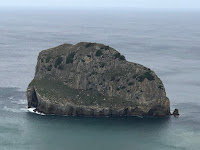
Our first stop was in Getxo for a 20-minute stop to take a look at the UNESCO transporter bridge. Twenty minutes didn't leave people with enough time take a ride across the river and back but we were fine since we already did the bridge thing the day before when we went to Portugalete.


San Juan de Gaztelugatxe has become even more popular when HBO digitally created a castle on top of the islet and created Dragonstone for the seventh season of Game of Thrones.
The Urdaibai Biosphere Reserve was declared a UNESCO Biosphere Reserve in 1984.
It covers an area of 220 km² (85 square miles) on the Bay of Biscay coast. It is home to about 45.000 people and 80% of them around towns of Bermeo and Gernika.
 Our next stop was the small fishing town of Bermeo about 11 km (7 miles) away. Bermeo was founded in 1236 and is home to almost 17.000 people.
Our next stop was the small fishing town of Bermeo about 11 km (7 miles) away. Bermeo was founded in 1236 and is home to almost 17.000 people.

 Then it was on to Gernika, the Basque name for Guernica, about 40 km (25 miles) east of Bilbao, where we stayed for about an hour.
Then it was on to Gernika, the Basque name for Guernica, about 40 km (25 miles) east of Bilbao, where we stayed for about an hour.
Guernica was founded in 1366 and is home to 17.000 people. It is a small market town but it is very important to Basque culture and identity.

The hall was built from 1826 - 1833. The Assembly House is also part museum because there's the Hall of Stained Glass, the Library and the former office of the President.


Guernica is most know for being bombed on 26 April 1937. During the Spanish Civil War, General Francisco Franco requested the Germans and Italians to help him overthrow the Basque Government and the Spanish Republic government. The German Luftwaffe used it as an opportunity to experiment with its blitzkrieg tactics which it later unleashed on Europe in WWII.
The city was bombed for three hours and more than 1500 people were killed.

Here's a short video I found on YouTube that helps interpret Picasso's masterpiece.




























No comments:
Post a Comment